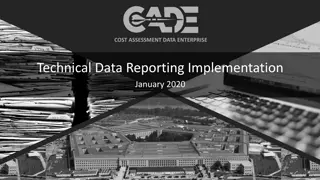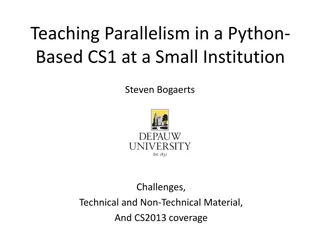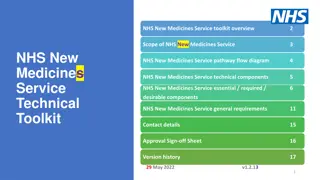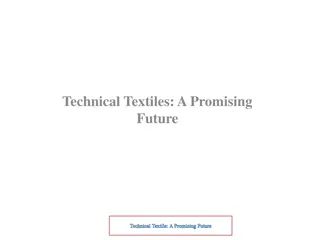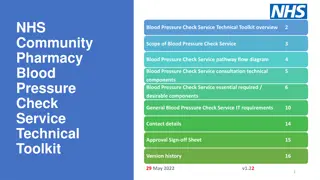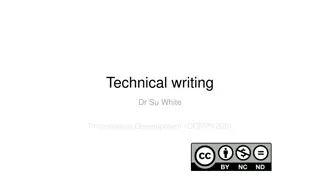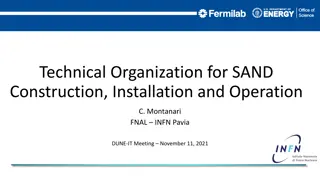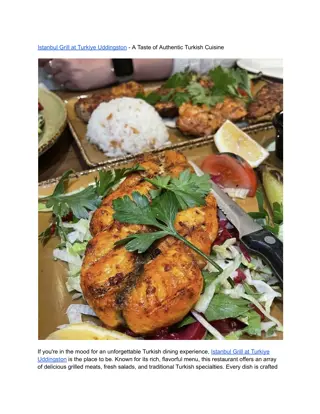
Insight into Food Colorants: Types, Regulations, and Usage
Explore the world of food colorants, from synthetic to natural options, their importance in enhancing food presentation, regulatory frameworks governing their use, and the practical applications in the food industry. Discover the history, classifications, methods, and outcomes related to the determination and use of colorants in food products.
Download Presentation

Please find below an Image/Link to download the presentation.
The content on the website is provided AS IS for your information and personal use only. It may not be sold, licensed, or shared on other websites without obtaining consent from the author. If you encounter any issues during the download, it is possible that the publisher has removed the file from their server.
You are allowed to download the files provided on this website for personal or commercial use, subject to the condition that they are used lawfully. All files are the property of their respective owners.
The content on the website is provided AS IS for your information and personal use only. It may not be sold, licensed, or shared on other websites without obtaining consent from the author.
E N D
Presentation Transcript
+ International Conference on Food Safety and Regulatory Measures August 17-19, 2015 Birmingham, UK Development of Novel Methods for The Determination of Synthetic Colorants F. Ay a zdemir Olgun Istanbul Technical University 18/08/15
+Content: A Brief Look at Colorants What are Food Colorants Classification Why do we use? Legislations and Limitations Objectives Methodology Experimental Studies Results Conclusion 18/08/15
+A Brief Look at Food Colorants What are food colorants?? Food colorants are an important class of food additives attracting the attention of consumers, and give the first impression about the taste and quality of a food product. Color in one form or another has been added to our foods for centuries. It is known that Egyptians colored candy and wine dating back to 400 BC. 18/08/15
+A Brief Look at Food Colorants Synthetic Food Colorants Natural Food Colorants Any artificially synthesized substance, manufactured by extracting from pigment or dye for coloring foods natural substances High Stability to light, oxygen and pH no limitation for the quantity low stability high cost Color uniformity Low microbiological contamination Relatively lower production costs (Alves et al. 2008) Some life-threatening risks (Kapadia et al. 1998; Eigenmann and Haenggeli 2007) 18/08/15
+A Brief Look at Food Colorants Why do we use?? to intensify the actual color of foods to obtain color stability in mass production to regain the lost color of a food after some food process coloring some types of food such as confectionary which are actually colorless 18/08/15
+A Brief Look at Food Colorants Legislations EU COMISSION (30 June 1994 on colors for use in foodstuffs) World Health Organization US Food and Drug Administration 18/08/15
+A Brief Look at Food Colorants Legislations E E Number E 155 E 160 E 163 E 124 E 170 E 171 E 173 E 174 E 175 E 180 E 110 Name of Colorant Brown HT Carotenoids Anthocyanines Ponceau 4R Calcium Carbonate Titaniumdioxide Alluminum Silver Gold Litolrubin BK Sunset Yellow Number E 100 E 101 E 102 E 132 E 133 E 141 E 142 E 150 E 151 E 153 E 154 Name of Colorant Curcumin Riboflavine Tartrazine Indigo Carmine Brilliant Blue Chlorophylls Green Amonnium Caramel Brilliant Black Carbon Brown FK 18/08/15
+Objectives Developing and investigating novel methods for the determination of synthetic food colorants Analyzing synthetic colorant content of food products Providing food control by informing consumers about the limitations of these substances Aiming the issues above, adapting in-vitro antioxidant assay CUPRAC for the determination of synthetic food colorants Correlation of proposed method results with HPLC findings Combination of in-vitro antioxidant assays with HPLC technique - application of online HPLC-CUPRAC technique 18/08/15
+Methodology In Literature Molecular Spectroscopy HPLC Voltammetry Synthetic Food Colorants Spectrophotometry in combination with chemometrics Capillary Electrophoresis 18/08/15
+Methodology CUPRAC(Cupric ion Reducing Antioxidant Capacity) The CUPRAC method is a simple and versatile antioxidant capacity assay useful for a wide variety of polyphenols, including phenolic acids, hydroxycinnamic acids, flavonoids, carotenoids,anthocyanins, as well as for thiols, synthetic antioxidants, and vitamins C and E. The chromogenic oxidizing reagent bis(neocuproine)copper(II) cation (Cu(II)-Nc) is used as an outer-sphere electrontransfer agent and by reduction of this reagent with antioxidants, bis(neocuproine) copper(I) cation (Cu(I)-Nc) is formed. nCu(Nc)22+ + n-electron reductant (AO) nCu(Nc)2+ n-electron oxidized product + n H+ R. Apak, K. Guclu, M. OzyUrek, S. E. Karademir and M. Altun, Free Radical Res., 2005, 39, 949 961. R. Apak, K. Guclu, M. Ozyurek, S. E. Karademir and E. Ercag, Int. J. Food Sci. Nutr., 2006, 57, 292 304. 18/08/15
+Methodology HPLC-PDA Technique Most preferred methods for the determination of synthetic food colorants are still chromatographic techniques coupled with ultraviolet (UV) or diode array detectors (Serdar and Knezevic 2009; Culzoni et al. 2009; Kirschbaum et al. 2006) There are two main problems with the use of single-wavelength UV detectors. Various UV visible (UV Vis) spectra with different maximum absorbance wavelengths long seperation time Possible overlap of colorant peaks or the presence of other organic compounds such as flavors in the sample. Both problems can be solved in the case of DADs. All dyes can be detected near to their maximum wavelength with the aid of multisignal detection capability, and peak identity can be easily confirmed. 18/08/15
+Methodology On-Line HPLC Derivatization Techniques Post-column derivatization involves the modification of the chromatographic system to allow the reaction to take place prior to entering the detector by inserting a post column reactor between the column and the detector. The post-column reactor is required to fulfill the following functions: 1)Provide a source of reagent and a means of mixing it efficiently with the column eluent. 2)Ensure the reaction is complete before the derivatized product enters the detector. 3)Minimize the dispersion that takes place in the reactor so that the integrity of the separation achieved by the column is maintained. 18/08/15
+ Experimental Studies Color index numbers, European codes, names and molecular formulas of analyzed synthetic colorants Color Index (CI) E Name of Molecular Formula Numbers 19140 Codes E 102 Colorants Tartrazine C16H9N4Na3O9S2 C16H10N2Na2O7S 2 15985 E 110 Sunset Yellow C16H8N2Na2O8S2 73015 E 132 Indigo Carmine C20H6I4Na2O5 45430 E 127 Erytrsosine C20H11N2Na3O10S3 16255 E 124 Ponceau 4R 18/08/15
+Experimental Studies Preparation of Standard and Sample Solutions Weighed as 100 mg and diluted to 100 mL Kept in ultrasonic bath for 30 min to achieve complete homogenization Tartrazine, sunset yellow, indigo carmine, erythrosine, ponceau4R The and were injected to the chromatographic system after through disposable syringe filters. Spectrophotometric CUPRAC procedure was applied. colorant sample standart solutions filtering 0.45 m Weighed as 100 mg and diluted to 50 mL Kept in ultrasonic bath for 30 min to achieve complete homogenization Powder beverage samples (orange, lemon, rosehip) were purchased from local market 18/08/15
+Experimental Studies Spectrophotometric Assays of Total Antioxidant Capacity Applied to the Determination of Total Colorant Content CUPRAC 1 mL Cu(II) + 1 mL Nc + 1 mL buffer solution (ammonium acetate solution) + x mL colorant solution + (1.1 - x) mL H2O; total volume of 4.1 mL, TCC (g/ 100 g)= ( Absorbance value / ponceau 4R) (total volume/ sample volume) Mwponceau 4R (g/mol) / amount of sample(g) 100 Let the mixture stand for 30 min at room temperature and measure the absorbance at 450 nm (Apak et al.2004,2005) 18/08/15
+Experimental Studies Chromatografic Methods Chromatographic Separation In order to achieve full resolution of all colorants, a variety of gradient elution programs were tested, using different mobile phases and changing retention times. But in all optimization experiments, the flow rate and injection volume were kept constant as 1 ml min 1 and 20 L, respectively. t A (%) 100 100 45 0 0 100 100 B (%) 0 0 55 100 100 0 0 F. A. Olgun, B. Demirata, R. Apak,Food Anal. Methods,2012,5: 1335-1341 Table 2. Optimized gradient elution program for the separation of colorants by HPLC-PDA (A: 0.13 M ammonium acetate solution, B: HPLC grade methanol) TCC HPLC= CiPECC i [Total sample amount (L) /sample amount (g)] 100 (min) 0 2 20 30 32 33 35 18/08/15
+Experimental Studies Chromatografic Methods Chromatographic Conditions Reversed phase C18 column system Gradient elution program (with mobile phase A: 0.13M ammonium acetate solution, B: methanol) Flow rate: 1mLmin-1 Injection volume: 20 L Detection: PDA detector monitoring each colorant at its own appropriate wavelength ( max was chosen as 485 nm for mutual evaluation of colorants) F. A. Olgun, B. Demirata, R. Apak,Food Anal. Methods,2012,5: 1335-1341 18/08/15
+ Experimental Studies On-line HPLC CUPRAC Assay HPLC Column (separated by optimized gradient elution program) Synthetic food colorants UV-Vis PDA Detector flow rate: 1 mLmin-1 CUPRAC reagent [3,33 10-3 M Cu(II) / 2,5 10-3 M Nc / 0,333 M NH4Ac (1:1:1, v/v/v)] UV Detector (detecting the chromatogram of Cu(I)- Nc at max=450nm) Reaction Coil Colorants mix with CUPRAC reagent flow rate: 0.5 mLmin-1 On-line HPLC-CUPRAC method assayed by Celik et. al. (2010) was applied directly to synthetic food colorants separating with the related gradient elution program. Colorants were let to react with CUPRAC reagent in a time period of 1 minute. TCC HPLC-CUPRAC= ( yi / slope) Total volume (L) / sample amount (g) 18/08/15 S. E. Celik, M. Ozyurek, K. Guclu and R. Apak, Anal. Chim. Acta, 2010, 674, 79 88.
+Results CUPRAC Assay of Total Antioxidant Capacity Applied to the Determination of Synthetic Food Colorants The indirect molar absorptivities and linear concentration ranges of the tested colorants with respect to the CUPRAC method (N=5) (LMOL-1CM- 1) ( 10-5 M) WORKING RANGES NAMEOF COLORANTS LOD (M) LOQ (M) CALIBRATIONEQUATIONS PECC A= (2.24 0.36) 104 CPONCEAU 4R (0.0227 0.0073), R = 0.9990 PONCEAU 4R (E124) 2.24 104 0.11 10-6 0.36 10-6 0.48 3.90 1.00 A= (1.34 0.12) 104 CTARTRAZINE (0.0060 0.0003), R = 0.9945 TARTRAZINE (E102) 1.34 104 1.48 10-6 4.93 10-6 0.58 4.64 0.60 A= (5.20 0.31) 103 CERYTHROSINE + (0.0087 0.0020), R = 0.9996 ERYTHROSINE (E127) 5.20 103 0.21 10-6 0.70 10-6 0.10 0.38 2.32 A= (1.49 0.06) 104 CSUNSETYELLOW + (0.0151 0.0041), R = 0.9996 SUNSET YELLOW (E110) 1.49 104 1.80 10-6 6.00 10-6 0.56 4.74 0.67 A= (1.03 0.11) 104 CINDIGOCARMINEO + (0.0829 0.0588), R = 0.9912 INDIGOCARMINE (E132) 1.03 104 1.91 10-6 6.38 10-6 0.11 0.91 0.46 18/08/15
+Results CUPRAC Assay of Total Antioxidant Capacity Applied to the Determination of Synthetic Food Colorants 0.50 y = 1.37 104 C + 0.13 R = 0.98 A 0.45 0.40 The interaction of orange powder beverage with tartrazine ( :1mL 10-2M CuCl2+ 1mL 7.5 10-3M Nc +1mL 1M NH4Ac+ tartrazine; : 1mL 10-2M CuCl2+ 1mL 7.5 10-3M Nc +1mL 1M NH4Ac+ orange powder beverage) 0.35 0.30 0.25 0.20 0.15 y =1.34 104 C - 0.06 R = 1.00 0.10 0.05 0.00 8.00 10.00 12.00 14.00 16.00 18.00 20.00 22.00 24.00 tartrazine + Ctartrazin 106(molL-1) A 0.45 y = 2.00 104 C + 0.10 R = 0.99 0.40 The interaction of rosehip powder beverage with ponceau 4R ( :1mL 10-2M CuCl2+ 1mL 7.5 10-3M Nc +1mL 1M NH4Ac+ ponceau 4R; : 1mL 10-2M CuCl2+ 1mL 7.5 10-3M Nc +1mL 1M NH4Ac+ ponceau 4R + rosehip powder beverage) 0.35 0.30 0.25 0.20 0.15 y = 0.22 106C - 0.02 R = 0.99 0.10 0.05 0.00 8.00 10.00 12.00 14.00 16.00 Cponceau 4R 106 (M) 18/08/15
+Results CUPRAC Assay of Total Antioxidant Capacity Applied to the Determination of Synthetic Food Colorants Relative Standard Deviation % and Recovery % of Synthetic Food Colorants added to powder beverage samples Colorant addition to powder beverages TCC Concentration added (M) Concentration expected (M) Concentration found (M) Recovery (%) (calculated with PECC coefficients) (M) 6.82 10-6 17.31 10-6 24.13 10-6 26.86 10-6 Tartrazine addition to orange powder beverage 111.0 21.49 10-6 28.31 10-6 32.01 10-6 113.0 4.58 10-6 12.76 10-6 18.23 10-6 16.72 10-6 Ponceau 4R addition to rosehip powder beverage 91.7 14.32 10-6 19.79 10-6 18.38 10-6 92.9 18/08/15
+Results Determination of Synthetic Food Colorants by HPLC- PDA The chromatogram of standard colorant mixture solution (Colorant mixture consists of 1: E102, 2: E132, 3: E110, 4: E124, 5: E127, respectively. Flow rate: 1mLmin-1; max: 485nm) AU E124 E110 E102 E127 E132 tR(min) 18/08/15
Results + Determination of Synthetic Food Colorants by HPLC-PDA Retention times (tR(min)), linear ranges, calibration equations, regression coefficients, LOD and LOQ values of the tested colorants with respect to HPLC-PDA technique Name of colorants ranges (M) max (nm) tR(min) Working Calibration Equation A= mC+n (A: Peak Area) A= (8.0 0.69) 1010 C + (1.07 2.50) 105 A= (2.06 0.16) 1011 C + (1.11 128.5) 105 A= (3.39 0.05) 1011 C - (1.06 1.17) 105 A= (6.60 0.61) 1010 C + (1.25 2.94) 105 A= (2.12 0.18) 1010 C + (7.02 17.02) 103 R2 LOD (M) LOQ (M) 17.43 0.05 8.27 10-6 8.27 10-5 7.56 10-6 25.21 10-6 Ponceau 4R (E124) 508 0.9935 14.58 0.03 9.20 10-6- 9.20 10-5 2.02 10-6 6.74 10-6 Tartrazine (E102) 427 0.9997 27.39 0.03 5.68 10-6 5.68 10-5 8.64 10-7 28.89 10-7 Erythrosine (E127) 528 0.9998 16.41 0.04 1.11 10-5 1.11 10-3 1.06 10-6 3.55 10-6 Sunset Yellow (E110) Indigo carmine (E132) 482 0.9995 13.53 0.03 1.91 10-6 1.91 10-5 1.47 10-6 4.87 10-6 608 0.9994 18/08/15
+Results Determination of Synthetic Food Colorants by HPLC-PDA The chromatogram of rosehip powder beverage monitored at max: 485nm (1: sunset yellow, 2: ponceau4R) 0.15 1 2 0.10 AU 0.05 0.00 0.00 5.00 10.00 15.00 20.00 25.00 30.00 35.00 Minutes The chromatogram of orange powder beverage monitored at max: 485nm (1: tartrazine, 2: ponceau4R) 0.10 2 AU 0.05 1 0.00 0.00 5.00 10.00 15.00 20.00 25.00 30.00 Minutes 18/08/15
+Results Determination of Synthetic Food Colorants by on- line HPLC-CUPRAC Method AU 3 4 5 1 2 4 5 1 2 3 Time (min) The chromatogram of synthetic mixture of synthetic food colorants mixture solution (consists of 1: E102, 2: E132, 3: E110, 4: E124, 5: E127), at 485 nm and 450 nm respectively. 18/08/15
+Results Determination of Synthetic Food Colorants by on-line HPLC-CUPRAC Method AU 1 2 Time (min) The chromatogram of rosehip powder beverage sample solution monitored at 485 nm and 450 nm, respectively. (Peak 1: sunset yellow; Peak 2: ponceau 4R) 18/08/15
+Results Determination of Synthetic Food Colorants by on- line HPLC-CUPRAC Method Retention times (tR(min)), linear ranges, calibration equations, regression coefficients, LOD and LOQ values of the tested colorants with respect to on-line HPLC-CUPRAC method Name of colorant tR Calibration equation A=mC(M)+n R2 working range ( 10-6 M) 0.46 3.71 LOD (M) LOQ (min) (M) 12.81 0.15 Tartrazine (E102) A= (7,27 1,31) 1011 C- (1,51 2,49) 105 A= (6.88 0.85) 1010 C (9.92 18.88) 104 A= (1.25 0.27) 1011 C (1.14 2.73) 104 A= (7.71 2.89) 1010 C (4.73 10.68) 105 A= (8.19 2.08) 1010 C (3.97 4.84) 105 0.9937 4.17 10-7 13.90 10-5 17.17 0.08 Sunset Yellow (E110) Erythrosine (E127) 0.9959 5.70 41,20 3.72 10-6 12.40 10-6 27.39 0.03 0.9990 0.26 2.10 0.27 10-7 0.90 10- 7 14.34 0.03 Indigo Carmine (E132) Ponceau 4R (E124) 0.9953 8.95 71.60 1.39 10-6 2.33 10- 6 17.43 0.05 0.9978 5.65 45.20 3.00 10-6 10.00 10-6 18/08/15
+Results Determination of Synthetic Food Colorants by on-line HPLC-CUPRAC Method Relative Standard Deviation and Recovery % of Synthetic Food Colorants added to powder beverage samples with respect to on-line HPLC-CUPRAC Method Colorant addition to powder beverage samplse Tartrazine addition to orange powder beverage 1.02 10-6 Ponceau 4R addition to rosehip powder beverage 9.77 10-6 Colorant content (M) Added concentratio n (M) Expected concentratio n (M) Found Concentrati on (M) Recovery (%) Tartrazine in orange powder beverage (M) 0.93 10-6 1.95 10-6 2.24 10-6 114.8 1.85 10-6 2.87 10-6 3.00 10-6 104.5 Ponceau 4R in rosehip powder beverage (M) 1.13 10-6 10.90 10-6 10.12 10-6 92.80 2.26 10-6 12.03 10-6 10.73 10-6 90.12 18/08/15
Results + Comparison of retention times (tR), limit of detection values (LOD) and limit of qualification values (LOQ) of tested colorants, with respect to HPLC-PDA technique and on-line HPLC-CUPRAC method Name of Colorant tR (HPLC-PDA) tR (on-line HPLC- CUPRAC) LOD (HPLC- PDA; 485 nm) LOD (on-line HPLC- CUPRAC, 485nm) 7.56 10-6 2.80 10-6 18.16 0.03 17.43 0.05 Ponceau 4R 2.02 10-6 4.17 10-7 12.81 0.15 12.03 0.08 Tartrazine 8.64 10-7 2.70 10-8 28.27 0.06 27.39 0.03 Erythrosine 1.06 10-6 3.72 10-7 17.17 0.08 16.41 0.04 Sunset Yellow 1.42 10-6 1.39 10-6 14.34 0.11 13.53 0.03 Indigo Carmine 18/08/15
The Analyses of Powder Beverage Samples + Colorant contents of powder beverage samples found by HPLC and on-line HPLC-CUPRAC assays (N=5) Name of Orange powder beverage Rosehip powder beverage (g/100g powder beverage) (g/100g powder beverage) colorant HPLC-PDA On-line HPLC- CUPRAC HPLC-PDA On-line HPLC- CUPRAC (485 nm) (485 nm) (450 nm) (450 nm) 0,61 0,02 0,45 0,03 0,29 0,03 0,28 0,04 Tartrazine (E102) Sunset Yellow (E110) Erythrosine (E127) Indigo Carmine (E132) Ponceau 4R (E124) 0,07 0,01 0,04 0,01 - - - - - - 0,24 0,02 0,22 0,01 - - 18/08/15
+ The Analyses of Powder Beverage Samples Total colorant contents of powder beverage samples found by HPLC (with CUPRAC calculations) and on-line HPLC-CUPRAC assays (N=5) Name of sample CUPRAC HPLC On-line HPLC- CUPRAC g Ponceau 4R/ 100 g (CUPRAC calculations ) g Ponceau 4R/ 100 g g Ponceau 4R/ 100 g 0.65 0.01 0.51 0.01 P= 0.05; Fexperimental = 8.04; Fcritical= 18.51; 0.85 0.01 0.68 0.02 CUPRAC, 0.76 0.02 0.49 0.01 Orange powder beverage Rosehip powder beverage HPLC (CUPRAC Fexperimental < Fcritical Statistical Analysis with two-way ANOVA Test calculated) and on-line HPLC- CUPRAC 18/08/15
+Conclusions In this study, determination of five synthetic food colorants was investigated using spectrophotometric and chromatographic methods. By adapting the novel spectrophotometric CUPRAC assay of total antioxidant capacity to the determination of total food colorant content, certain beverage samples were easily and accurately analyzed. The total colorant content was found at low reagent and instrumentation costs with the use of a UV vis spectrophotometer easily found in a conventional laboratory equipped with simple instruments. 18/08/15
+Conclusions HPLC analysis of colorants was performed with two different techniques. 1)In conventional HPLC method, PDA detector system was used to monitor each colorant at its maximum absorbance wavelength. The selected mobile phase for the gradient elution program enabled the shortening of total analysis time when compared to other chromatographic methods. Furthermore, since acetonitrile as the conventional solvent was not used in the eluent, solution costs were minimized. 2)On-line HPLC-CUPRAC was adapted for the determination of synthetic food colorants. Optimized gradient elution program was used for the separation of colorants. Retention time periods were increased due to additional installation for derivatization coil. However, LOD values were decreased with on-line HPLC-CUPRAC method. 18/08/15
+Conclusions Two-way ANOVA test results were calculated for CUPRAC, HPLC (with CUPRAC calculations) ve on-line HPLC-CUPRAC (P= 0,05; Fexperimental= 0,26; Fcritical= 18,51; Fexperimental< Fcritical) with 95% confidence levels. 18/08/15
+ THANK YOU... 18/08/15


